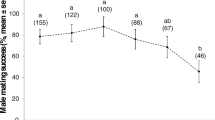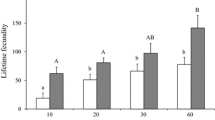Abstract
The study of male insects’ accessory gland (MAG) secretions will promote our understanding of reproductive strategies and their evolution, and will facilitate the development of new approaches for pest control. Here, we carried out a series of experiments to determine the functions of MAG secretions on modulating female post-mating behavior in the moth Spodoptera litura. Results showed that females injected with MAG secretions called and mated significantly less than controls in the night after treatment, which were independent of mechanical stimulation during mating and the presence of sperm. However, a successful mating resulted in a longer loss in sexual receptivity (lasting to the second night after mating). This study also demonstrated that MAG secretions not only triggered oviposition but also promoted egg development, which also were not dependent on mechanical stimulation during mating and the presence of sperm. MAG secretions also showed negative effect on female longevity, which may be because MAG secretions stimulate females to allocate more resources to egg development and oviposition, leaving fewer resources for survival. Results of this study also suggest that oviposition behaviors incur energy costs. The hypothesis that virgin females may conduct oosorption to prolong longevity is not supported.




Similar content being viewed by others
References
Armes NJ, Wightman JA, Jadhav DR, Rao GVR (1997) Status of insecticide resistance in Spodoptera litura in Andhra Pradesh, India. Pestic Sci 50:240–248
Avila FW, Ram KR, Qazi MCB, Wolfner MF (2010) Sex peptide is required for the efficient release of stored sperm in mated Drosophila females. Genetics 186:595–600
Baer B, Maile R, Schmid-Hempel P, Morgan DE, Jones GR (2000) Chemistry of a mating plug in bumblebees. J Chem Ecol 26:1869–1875
Calvert I, Corbet SA (1973) Reproductive maturation and pheromone release in the flour moth Anagasta kuehniella (Zeller). J Entomol Ser A Physiol Behav 47:201–209
Crudgington HS, Siva-Jothy MT (2000) Genital damage, kicking and early death—the battle of the sexes takes a sinister turn in the bean weevil. Nature 407:855–856
Daniel WW (1990) Applied nonparametric statistics. PWS-Kent, Boston
Danielsson I (1998) Mechanisms of sperm competition in insects. Ann Zool Fenn 35:241–257
Darwin CR (1859) On the origin of species by means of natural selection, or the preservation of favoured races in the struggle for life. John Murray, London
Dixson A (2002) Sexual selection by cryptic female choice and the evolution of primate sexuality. Evol Anthropol 11:195–199
Eberhard WG (1996) Female control: sexual selection by cryptic female choice. Princeton University Press, Princeton
Edwards RL (1954) The effect of diet on egg maturation and resorption in Mormoniella vitripennis (Hymenoptera, Pleromalidae). Q J Microsc Sci 95:459–468
Fedina TY (2007) Cryptic female choice during spermatophore transfer in Tribolium castaneum (Coleoptera: Tenebrionidae). J Insect Physiol 53:93–98
Foster SP, Howard AJ, Ayers RH (1995) Age-related-changes in reproductive characters of 4 species of Tortricid moths. N Z J Zool 22:271–280
Fukuda T, Wakamura S, Arakaki N, Yamagishi K (2007) Parasitism, development and adult longevity of the egg parasitoid Telenomus nawai (Hymenoptera: Scelionidae) on the eggs of Spodoptera litura (Lepidoptera: Noctuidae). Bull Entomol Res 97:185–190
Giebultowicz JM, Raina AK, Uebel EC, Ridgway RL (1991) Two-step regulation of sex-pheromone decline in mated gypsy moth females. Arch Insect Biochem 16:95–105
Gillott C (2003) Male accessory gland secretions: modulators of female reproductive physiology and behavior. Annu Rev Entomol 48:163–184
Heifetz Y, Tram U, Wolfner MF (2001) Male contributions to egg production: the role of accessory gland products and sperm in Drosophila melanogaster. Proc Roy Soc Lond B Bio 268:175–180
Hotzy C, Arnqvist G (2009) Sperm competition favors harmful males in seed beetles. Curr Biol 19:404–407
Kamimura Y (2007) Twin intromittent organs of Drosophila for traumatic insemination. Biol Lett 3:401–404
Kingan TG, Bodnar WM, Raina AK, Shabanowitz J, Hunt DF (1995) The loss of female sex pheromone after mating in the corn earworm moth Helicoverpa zea: identification of a male pheromonostatic peptide. Proc Natl Acad Sci U S A 92:5082–5086
Kotaki T (2005) Oosorption in the stink bug, Plautia crossota stali: follicle cells as the site of protein degradation. Invertebr Reprod Dev 47:147–153
Lentz AJ, Miller JR (1996) Effect of male accessory gland extracts on induction of oviposition in the gypsy moth, Lymantria dispar (Lymantriidae). J Lepid Soc 50:226–236
Li G, Chen Q, Pang Y (1998) Studies of artificial diets for the beet armyworm, Spodoptera exigua. Acta Sci Nat Univ Sunyatseni 4:1–5
Li W, Zou WJ, Wang LH (2006) The bionomics and control of Prodenia litura in Kunming. Southwest China J Agric Sci 19:85–89
Li C, Yu J-F, Xu J, Liu J-H, Ye H (2012) Reproductive rhythms of the tobacco cutworm, Spodoptera litura (Lepidoptera: Noctuidae). GSTF J BioSci 2:25–29
McNamara KB, Elgar MA, Jones TM (2008) Seminal compounds, female receptivity and fitness in the almond moth, Cadra cautella. Anim Behav 76:771–777
Nagalakshimi VK, Applebaum SW, Azrielli A, Rafaeli A (2007) Female sex pheromone suppression and the fate of sex-peptide-like peptides in mated moths of Helicoverpa armigera. Arch Insect Biochem 64:142–155
Obara Y, Tateda H, Kuwabara M (1975) Mating behavior of the cabbage white butterfly Peiris rapae crucivora V. Copulatory stimuli inducing changes of female response patterns. Zool Mag (Tokyo) 84:71–76
Ohgushi T (1996) A reproductive tradeoff in an herbivorous lady beetle: egg resorption and female survival. Oecologia 106:345–351
Ottiger M, Soller M, Stocker RF, Kubli E (2000) Binding sites of Drosophila melanogaster sex peptide pheromones. J Neurobiol 44:57–71
Parker GA (1982) Why are there so many tiny sperm—sperm competition and the maintenance of 2 sexes. J Theor Biol 96:281–294
Poiani A (2006) Complexity of seminal fluid: a review. Behav Ecol Sociobiol 60:289–310
Raina AK (1993) Neuroendocrine control of sex pheromone biosynthesis in Lepidoptera. Annu Rev Entomol 38:320–349
Raina AK, Werginb WP, Murphyb CA, Erbe EF (2000) Structural organization of the sex pheromone gland in Helicoverpa zea in relation to pheromone production and release. Arthropod Struct Dev 29:343–353
Ram KR, Wolfner MF (2007) Seminal influences: Drosophila Acps and the molecular interplay between males and females during reproduction. Integr Comp Biol 47:427–445
Rönn J, Katvala M, Arnqvist G (2007) Coevolution between harmful male genitalia and female resistance in seed beetles. Proc Natl Acad Sci U S A 104:10921–10925
Simmons LW (2001) Sperm competition and its evolutionary consequences in the insects. Princeton University Press, Princeton
Sugawara T (1981) Fine structure of the stretch receptor in the bursa copulatrix of the butterfly, Pieris rapae crucivora. Cell Tissue Res 217:23–36
Tatarnic NJ, Cassis G, Hochuli DF (2006) Traumatic insemination in the plant bug genus Coridromius Signoret (Heteroptera: Miridae). Biol Lett 2:58–61
Thibout E (1979) Stimulation of reproductive activity of females of Acrolepiopsis assectella (Lepidoptera, Hyponomeutoidea) by the presence of eupyrene spermatozoa in the spermatheca. Entomol Exp Appl 26:279–290
Trivers R (1972) Parental investment and sexual selection. In: Champbell B (ed) Sexual selection and the descent of man. Aldine, Chicago, pp 136–179
Wang MH, Horng SB (2004) Egg dumping and life history strategy of Callosobruchus maculatus. Physiol Entomol 29:26–31
Xu J, Wang Q (2009) Male moths undertake both pre- and in-copulation mate choice based on female age and weight. Behav Ecol Sociobiol 63:801–808
Xu J, Wang Q (2011) Seminal fluid reduces female longevity and stimulates egg production and sperm trigger oviposition in a moth. J Insect Physiol 57:385–390
Xue M, Pang Y-H, Wang H-T, Li Q-L, Liu T-X (2010) Effects of four host plants on biology and food utilization of the cutworm, Spodoptera litura. J Insect Sci 10:1–14
Yapici N, Kim YJ, Ribeiro C, Dickson BJ (2008) A receptor that mediates the post-mating switch in Drosophila reproductive behaviour. Nature 451:33–37
Zar JH (1999) Biostatistical analysis. Prentice Hall, Upper Saddle River
Acknowledgments
Research reported here was supported by projects from the National Natural Science Foundation Program of P.R. China (31160434 and 31260105), and the Department of Science and Technology of Yunnan Province of P.R. China (2011FZ004) and the Department of Education of Yunnan Province, P.R. China (2011Z110).
Author information
Authors and Affiliations
Corresponding authors
Additional information
Jin-Feng Yu and Cong Li contributed equally.
Rights and permissions
About this article
Cite this article
Yu, JF., Li, C., Xu, J. et al. Male Accessory Gland Secretions Modulate Female Post-Mating Behavior in the Moth Spodoptera litura . J Insect Behav 27, 105–116 (2014). https://doi.org/10.1007/s10905-013-9414-4
Revised:
Accepted:
Published:
Issue Date:
DOI: https://doi.org/10.1007/s10905-013-9414-4




